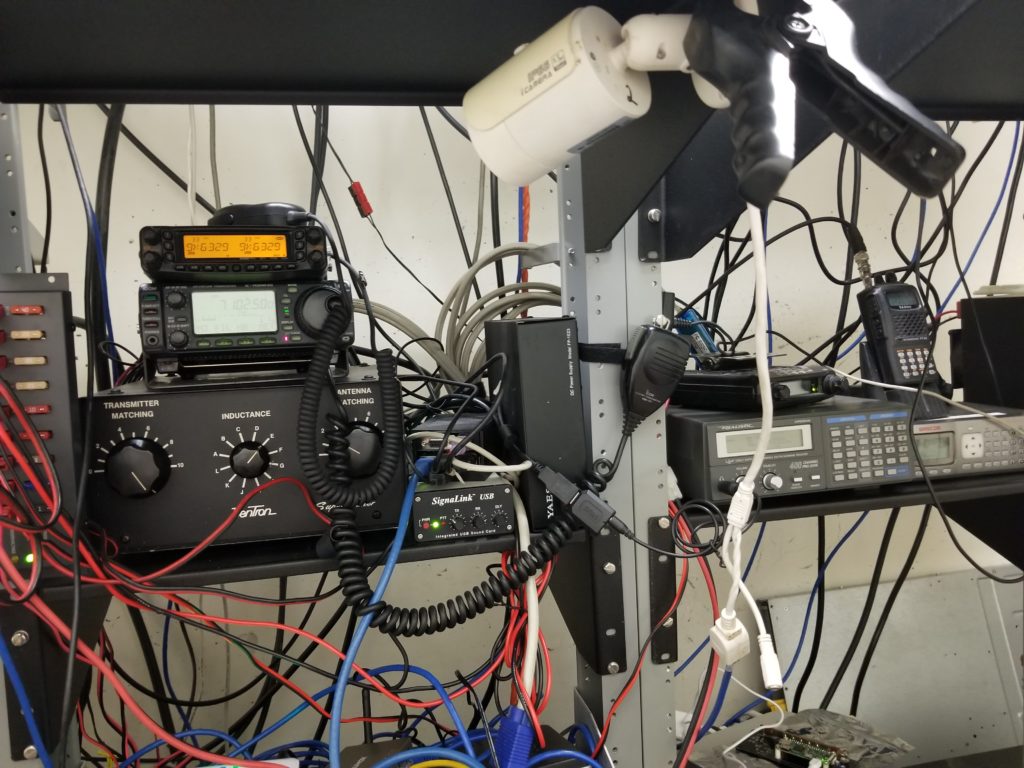There is a BPQ packet node at The University of Texas at Austin. The means to reach this packet station is kept updated at https://ka5d.com/repeaters. This article describes the station purpose and how it was built.

The heart of the packet station is a Raspberry Pi 3B+ with a TNC-Pi9k6 hat with Teensy 3.6. This hardware TNC plugs into the GPIO pins of the pi and came with a box that also contains the pi in a tidy package. The TNC-Pi9k6 is used for 9600 baud communication on 432.95 MHz and is connected via 6-pin mini-din serial cable to a Kenwood TM-V71a. The signal path for this radio also includes a two-cavity filter, heliax, and a Diamond X-50NA antenna. If you haven’t tried 9600 baud yet, I encourage you to give it a try. The speed is a game changer.
There is a two meter 1200 baud channel at 145.73 Mhz to connect to this node. The pi is connected by a Signalink to a Yaesu FT-1500M. It also has a cavity filter in its signal path leading to a Diamond X-300 antenna.
For long distance operation, there is a 40-meter channel on 7.104 LSB (dial frequency) 300 baud packet as well. The center of the signal is at 1700 Hz in the passband. Connected to the pi is yet another Signalink to an Icom 706-MkIIg. The signal path includes a Dentron Super Tuner connected by coax/balun/ladder-line feed to a 40-meter horizontal loop sky wire antenna.

All of these things exist atop a tall building about 200′ AGL. Because the packet station is co-located with several other repeaters and radio services, everything must be carefully filtered to reject and prevent RFI. Due to its position and height, this UT node serves well as a digipeater for other nodes & users on all bands it operates.

The station is designed for security and high availability. It resides in a secure room behind a secure network with climate control and emergency power in a commercial building. The pi itself is backed up regularly.

The software running this packet node is BPQ. Services it provides include a BBS for mail and bulletins, a live chat server, and ability to connect to other BPQ nodes around the world. The connectivity to other nodes is provided by a hybrid network of AXIP (AX.25 protocol over IP) tunnels to other nodes, as well as RF fallback. Through a mix of AXIP links, HF connectivity, and links to other local nodes in the Austin area, it is possible to connect and communicate by packet all over the world. Through an RMS link with N4NVD-3:RNDRCK node in Round Rock, we can also send/receive Internet email using the BSS via the Winlink system, whereby the BBS acts as your Winlink client.
The main purpose of building it is to have fun with packet, and secondary to that is providing alternate communications when Internet isn’t available. A pleasant by-product of this project has been meeting fellow packeteers, many of whom have been generous with their time and talent to help us get up and running. I recognize Mark N5MDT, Charlie N4NVD, Kayne N9SEO, Clint KI5HMI, Tim KF5RLL as folks who really helped us out in many ways. We encourage radio amateurs all over Central Texas and the world to fire up your modems and visit the node. It will respond to either KA5D-7 or its alias, UT. Enjoy!
Leave a Reply